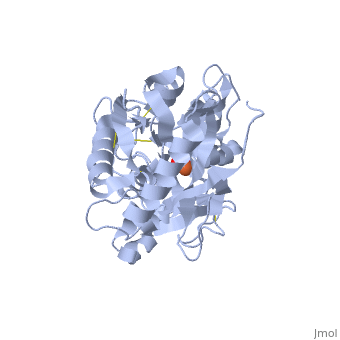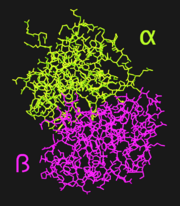Human lactoferrin
From Proteopedia
(Difference between revisions)
| Line 8: | Line 8: | ||
=Structure= | =Structure= | ||
[[Image:1DSN_Domains.png|left|thumb|'''Figure 1.''' Cartoon illustrating the alpha (green) and beta (magenta) domains of LF<sub>N</sub>]] | [[Image:1DSN_Domains.png|left|thumb|'''Figure 1.''' Cartoon illustrating the alpha (green) and beta (magenta) domains of LF<sub>N</sub>]] | ||
| + | {{Clear}} | ||
The amino-terminal half-molecule of human lactoferrin (LF<sub>N</sub>) is comprised of a single 333 amino acid chain divided into two similarly-sized α and β domains. The iron binding site is located within a deep cleft between the lobes, where iron is bound by <scene name='Sandbox_Reserved_302/Helix_3_and_5/2'>Helices 3 and 5</scene> of the α and β domains, respectively. Iron, which is bound to a carboxylate ion, is bound by Asp60, Ala123, and Gly124. Although unwound in LF<sub>N</sub>, <scene name='Sandbox_Reserved_302/Pigtail/1'>residues 313 to 333</scene> form a helix when joined to LF<sub>C</sub>, forming the full LF protein.<ref name="faber" /> | The amino-terminal half-molecule of human lactoferrin (LF<sub>N</sub>) is comprised of a single 333 amino acid chain divided into two similarly-sized α and β domains. The iron binding site is located within a deep cleft between the lobes, where iron is bound by <scene name='Sandbox_Reserved_302/Helix_3_and_5/2'>Helices 3 and 5</scene> of the α and β domains, respectively. Iron, which is bound to a carboxylate ion, is bound by Asp60, Ala123, and Gly124. Although unwound in LF<sub>N</sub>, <scene name='Sandbox_Reserved_302/Pigtail/1'>residues 313 to 333</scene> form a helix when joined to LF<sub>C</sub>, forming the full LF protein.<ref name="faber" /> | ||
| Line 23: | Line 24: | ||
[[Lactoferrin]] | [[Lactoferrin]] | ||
| - | + | </StructureSection> | |
=References= | =References= | ||
<references /> | <references /> | ||
Page originally authored by Christian Axen | Page originally authored by Christian Axen | ||
Revision as of 14:12, 21 December 2014
| |||||||||||
References
- ↑ 1.0 1.1 1.2 1.3 1.4 Faber HR, Bland T, Day CL, Norris GE, Tweedie JW, Baker EN. Altered domain closure and iron binding in transferrins: the crystal structure of the Asp60Ser mutant of the amino-terminal half-molecule of human lactoferrin. J Mol Biol. 1996 Feb 23;256(2):352-63. PMID:8594202
- ↑ 2.0 2.1 2.2 Farnaud S, Evans RW. Lactoferrin--a multifunctional protein with antimicrobial properties. Mol Immunol. 2003 Nov;40(7):395-405. PMID:14568385
- ↑ 3.0 3.1 3.2 Sanchez L, Calvo M, Brock JH. Biological role of lactoferrin. Arch Dis Child. 1992 May;67(5):657-61. PMID:1599309
- ↑ Gerstein M, Anderson BF, Norris GE, Baker EN, Lesk AM, Chothia C. Domain closure in lactoferrin. Two hinges produce a see-saw motion between alternative close-packed interfaces. J Mol Biol. 1993 Nov 20;234(2):357-72. PMID:8230220 doi:http://dx.doi.org/10.1006/jmbi.1993.1592
- ↑ 5.0 5.1 van der Strate BW, Beljaars L, Molema G, Harmsen MC, Meijer DK. Antiviral activities of lactoferrin. Antiviral Res. 2001 Dec;52(3):225-39. PMID:11675140
Page originally authored by Christian Axen
Proteopedia Page Contributors and Editors (what is this?)
Karsten Theis, Alexander Berchansky, Michal Harel, Andrea Gorrell


